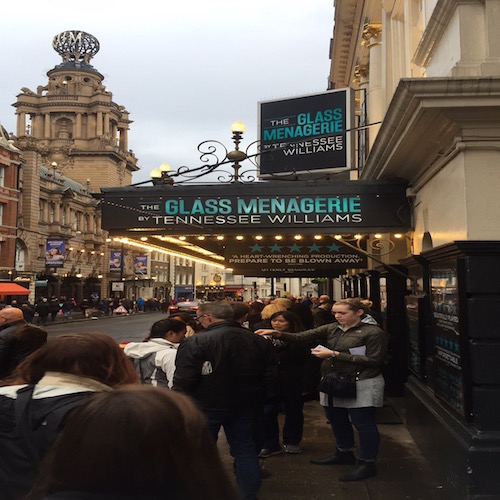The Glass Menagerie, written by Tennessee Williams, is the heart wrenching story of a family of three in America. This classic was first performed in 1944 and appeared on Broadway in 1945. We saw it performed in the Duke of Yorks Theatre, London, as directed by John Tiffany. This “memory play” is the semi-autobiographical story of Williams’ own struggles with his past.

The story follows Tom, as played by Michael Esper, as he looks back on his relationships with his mother and sister in the St. Louis during the 1930s. What makes this performance truly exceptional is its ability to draw the audience into Tom’s mind. Take for example the opening scene. Tom appears onstage and informs the audience that none of what we are about to see is real, it is only a memory. He describes exactly what we will see in the play: his mother, his sister, himself, a mystery man, and a character without an actor— his father. The set begins to transform before the audience’s eyes. A moon, a balcony that goes on forever, and a small glass unicorn glittering in the light are all illuminated as Tom narrates his memory. The audience becomes immersed in this recollection as Laura seemingly appears out of nowhere and emerges from the couch. Tom literally falls into this memory and the play begins. This scene perfectly demonstrates the brilliance of this performance because it immediately places the audience into the memory.

While the play is ultimately about Tom’s guilt, Williams’ genius illustrates the complex relationships between Tom, his mother Amanda (Cherry Jones), and his sister Laura (Kate O’Flynn). Amanda is an aging Southern Belle who cares deeply for her 20-something year old children, but her outdated ideas and overbearing attitude stifle them in ways she does not recognize. She constantly reminds them of her youth, where she had many, many gentleman callers and a promising future, in the hopes that one day her children can have what she once had. This angers Tom, who works long hours at a warehouse he hates and since their father left, is responsible for supporting the family. Tom has different dreams. He wants to have adventures and write, earning him the nickname “Shakespeare”. To escape the arguments he has with his mother over this, he goes to “the movies”. These fights distress Laura immensely, who is kind and mild mannered. She keeps to herself much of the time, and is not very interested in anything other than her glass menagerie, which she treasures. Both Tom and Amanda worry about Laura, who has a limp and lacks confidence. Amanda fears that Laura, who has no gentleman callers, will become destitute. Amanda tells Tom to find a man at the workhouse to be Laura’s suitor. After initial reluctance, Tom brings home Laura’s high school crush, Jim (Brian Smith).

The romance between Jim and Laura was undoubtedly the most convincing we have seen in a play thus far. Jim cares about who Laura is as a person. He asks Laura about what she likes to do and her aspirations. Until this conversation, the audience only catches glimpses of the real Laura. With Jim, she opens up completely and the audience sees the sweet, thoughtful person that Laura is. What makes this truly heartbreaking is that the audience knows this love cannot last: Tom’s introduction lurks in the back of our minds. Despite this, the performance of this scene was so convincing that we believe it may work out and a happy ending is still possible. Alas, the rug is pulled out from under us as the end of the play is guaranteed to break your heart and possibly make you cry, as the fairytale shatters like Laura’s beloved glass unicorn.
Though the men in this play have questionable southern accents, the characters were entirely believable. The cast played their characters with sincerity and consistency. Additionally, they utilized the space well, never making the audience feel as if there was a gap to be filled on stage. As noted in Jane’s class, there were many directorial decisions that led to this outcome. In other performances, there were multiple figurines in the glass menagerie, yet the one we saw only had one. This forces the audience to imagine the many other figurines Laura describes in the play, further submerging us into a dream like world the director has created. Many of the actions onstage, such as setting the table and eating, had to be imagined by the audience. The actors would pantomime these activities, but no props existed. Further, there was a pool between the actors and the audience that reflected the characters, adding to this dream. Finally, all of the characters, though flawed, are lovable. This is not the case in other performances, where Amanda is portrayed as a monster. Whether this was a decision on the part of the actor or director, this choice makes us feel Tom’s guilt over these memories even more.

Overall, I would highly recommend this play. The set will delight and fascinate you, with its whimsical tower of balconies, magical couch, and tiny unicorn figurine. You will get wrapped up in the lives and stories of these characters, who will make you laugh and even cry. Because of the complex relationships illustrated in this play, one will leave not only entertained but asking whose actions were justified and if it could have ended differently. This performance offers a different take on this heart wrenching classic and is worth seeing whether it is your first or 100th time.
-Katherine Jones ‘18
